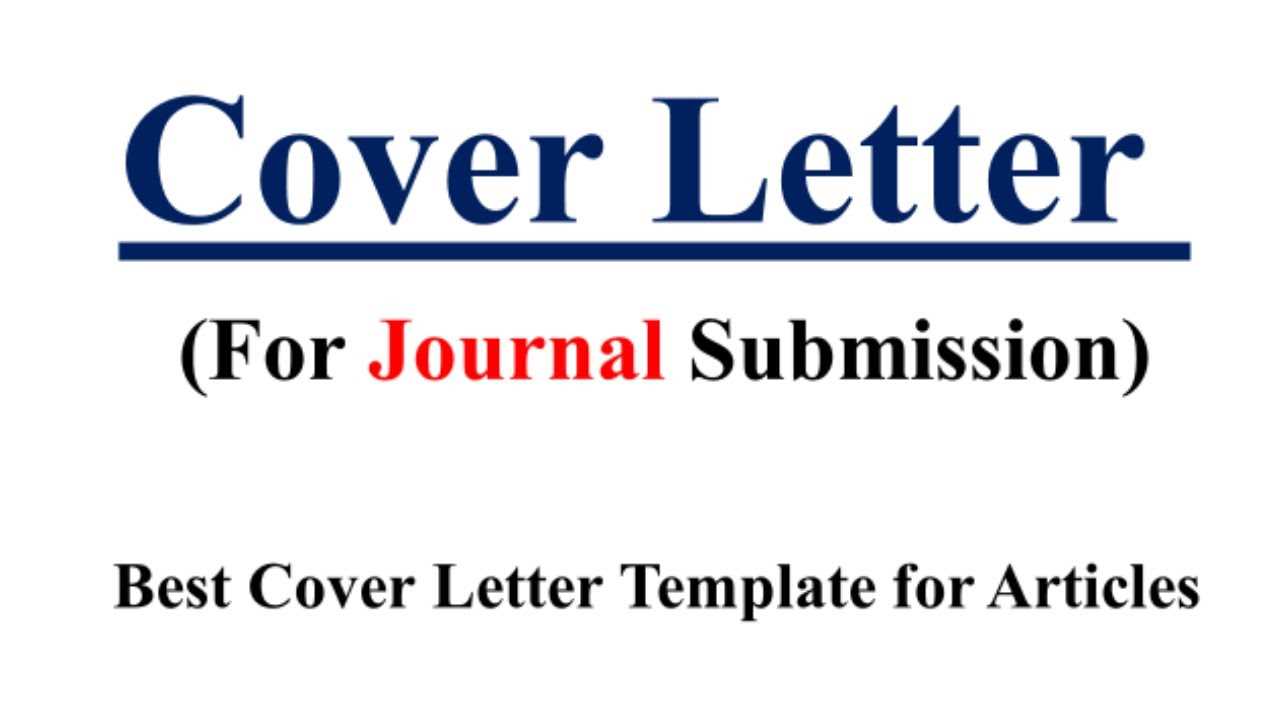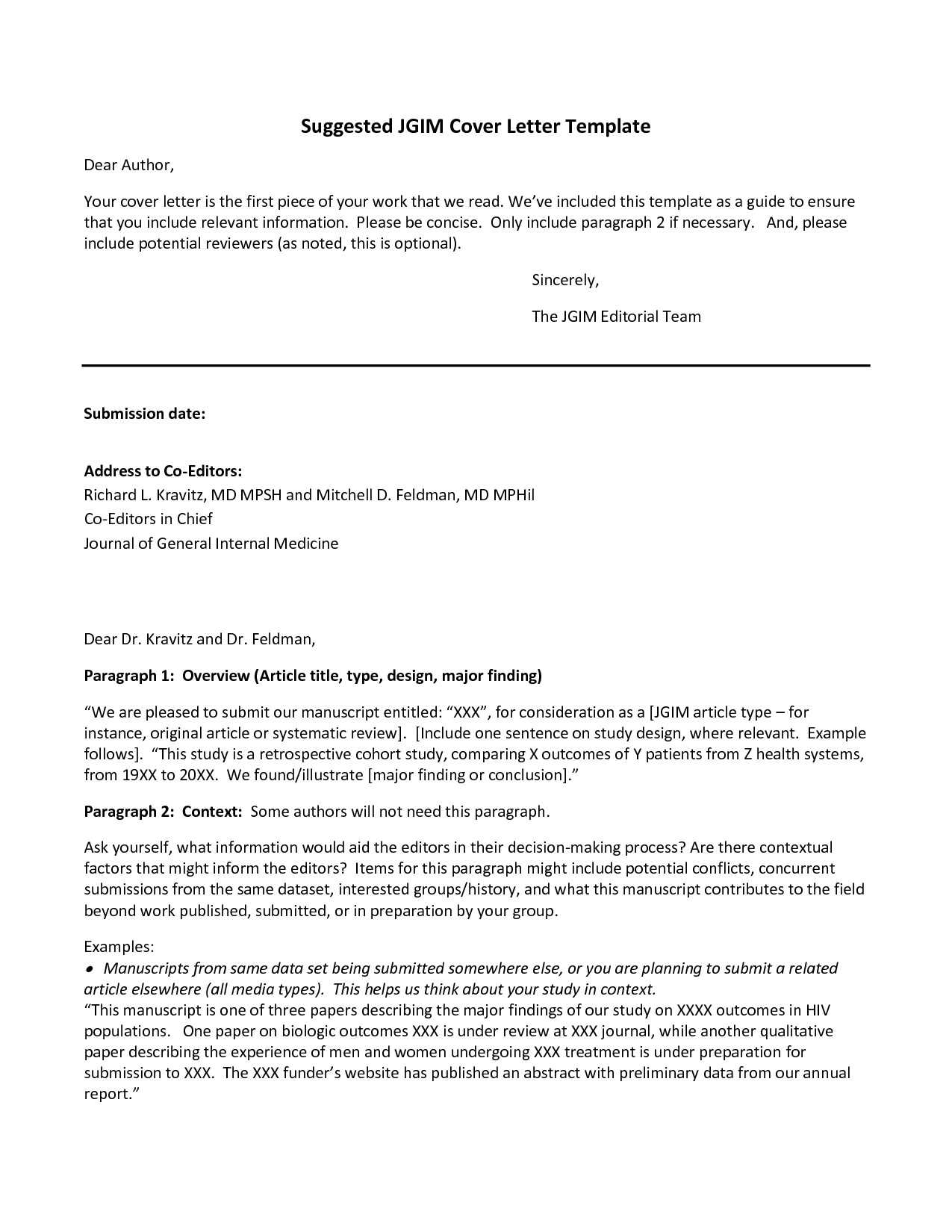Template cover letter journal submission

Crafting a strong cover letter for journal submission is key to making a positive first impression with editors. A well-written letter clearly introduces your work and establishes its relevance to the journal’s scope. Avoid overloading the letter with excessive details; instead, focus on concisely presenting the main points. Include the title of your paper, the type of manuscript you are submitting, and why your work fits with the journal’s aims.
Make sure to mention any previous correspondence or discussions related to the submission. In addition, highlight how your research contributes to the existing literature and the significance of your findings. A straightforward, clear tone ensures that your letter is easy to read, allowing editors to quickly grasp the key aspects of your work.
Conclude the letter by expressing your willingness to address any feedback and your enthusiasm for the potential publication. A well-crafted cover letter can set the tone for the review process and help editors understand why your paper is worth considering.
Here’s the revised version without redundancies:
Eliminate unnecessary repetition by structuring your cover letter clearly. Keep the introduction concise and directly mention the manuscript title, the journal you’re submitting to, and the purpose of your submission. Avoid restating the manuscript’s content in excessive detail.
Key Points to Highlight
In the body of the letter, briefly introduce the key findings or significance of your work, focusing on aspects that align with the journal’s scope. Mention any previous work or research that directly relates, but do not repeat the abstract or results section. Mention potential conflicts of interest only if relevant to your submission.
Closing Remarks
End your letter by thanking the editor for considering your submission. Reaffirm your enthusiasm about the possibility of publication and express your readiness to provide any additional information if needed. Keep this section polite, brief, and direct.
- Template for Cover Letter Submission
A well-crafted cover letter is key when submitting to a journal. Here’s a clear, step-by-step template to guide you:
1. Salutation
- Address the editor by name if possible. Use a professional salutation such as “Dear Dr. [Last Name]” or “Dear Editor”.
- If the editor’s name is unknown, use “Dear Editorial Team” or “Dear [Journal Name] Editorial Board”.
2. Introduction

- Briefly introduce your manuscript and its title.
- State the type of manuscript (original research, review, etc.) you are submitting.
- Include a sentence about the relevance or significance of your work in relation to the journal’s scope.
3. Main Body
- Summarize the purpose of the manuscript and its key findings or arguments.
- Clarify why you believe your manuscript fits the journal’s scope and audience.
- Note any special considerations, such as whether the manuscript has been previously submitted elsewhere or if it contains supplementary data.
4. Closing Remarks
- Express gratitude to the editor for considering your submission.
- Reaffirm your willingness to provide further information if needed.
- End with a polite closing like “Sincerely” or “Best regards”.
5. Signature
- Include your full name, title, and affiliation.
- Optionally, provide your contact information.
Adhere to the specific formatting requirements of the journal when drafting your cover letter. Most journals have clear guidelines on font type, size, and spacing, so check those details carefully. If the journal doesn’t specify, use a standard, professional format that includes a clear structure and easy readability.
The letter should be concise and direct, with formal language throughout. Keep paragraphs short and to the point, highlighting key elements such as the manuscript title, its significance, and your reasons for submitting it to that particular journal.
| Aspect | Recommended Format |
|---|---|
| Font | Times New Roman or Arial |
| Font Size | 12 pt |
| Line Spacing | 1.5 or Double |
| Margins | 1 inch on all sides |
| Paragraphs | Short and direct, without unnecessary details |
Always keep the tone formal and respectful, avoiding overly casual expressions. Stick to a professional voice and make sure the letter is easy to read without distractions.
Include key details about your manuscript to help editors assess its relevance and fit for the journal. Start by clearly stating the title, ensuring it is accurate and aligns with the subject matter. If applicable, mention the type of manuscript (research article, review, case study, etc.) and the target audience.
- Title of the Manuscript: Ensure it reflects the content and purpose clearly. Avoid jargon that might confuse readers outside your field.
- Authors: List all contributing authors along with their affiliations, including any co-authors, with proper credits and contributions.
- Abstract: Summarize the manuscript’s core argument, methods, findings, and conclusions in a concise and clear manner.
- Keywords: Provide relevant keywords that accurately reflect the manuscript’s focus, aiding discoverability in databases.
- Scope and Purpose: Briefly describe why the manuscript is a good fit for the journal’s scope and audience, highlighting its relevance.
- Previous Submissions: Mention if the manuscript has been submitted to other journals and note any revisions or resubmissions.
By presenting this information upfront, you make it easier for editors to process your submission and determine if it aligns with the journal’s guidelines and objectives.
Use a formal salutation to address the editor, such as “Dear [Editor’s Name]” or “Dear [Journal Name] Editorial Team.” If you are unsure of the editor’s name, it is acceptable to use “Dear Editor.” Avoid overly casual greetings like “Hello” or “Hi.” Maintaining a respectful and formal tone establishes your professionalism from the start.
Specificity and Personalization
Personalize your salutation by using the editor’s full name if known. If the editor is listed on the journal’s website or in prior correspondence, use it. Addressing the editor directly shows you’ve done your research and adds a personal touch that helps your submission stand out.
Clarity and Directness

Ensure that the tone of your letter is respectful and direct. Avoid flowery language or excessive compliments. A clear approach will communicate that you value the editor’s time. Keep your communication succinct and to the point, making it easy for the editor to assess your submission efficiently.
Directly highlight the key aspects of your work that align with the journal’s objectives. Focus on the specific themes or research areas the journal emphasizes. If the journal concentrates on a particular field, such as clinical research or environmental science, mention how your study contributes to these areas. Avoid vague statements–be clear about the unique contributions your paper brings to the journal’s targeted audience.
Linking Your Study to Journal Priorities

Draw a direct connection between the journal’s goals and your research. If the journal highlights innovation in a particular method, theory, or application, explain how your work introduces new approaches or advances existing knowledge in that area. Be specific about how your findings resonate with the journal’s ongoing discussions or existing articles. This establishes relevance and demonstrates a deep understanding of the journal’s aims.
Support with Examples
Include concrete examples from your work that demonstrate its relevance. For instance, if the journal focuses on emerging technologies, describe how your research addresses this trend with current examples or data. Ensure the examples you provide reflect the journal’s tone, audience, and focus. This helps editors and reviewers see that your manuscript is a natural fit for the journal’s scope.
Clearly state what makes your research stand out. Highlight the unique aspects of your methodology, findings, or theoretical approach. Show how your work fills a gap in existing literature or addresses an underexplored problem. Present your results as significant steps forward in the field and outline how they build on or challenge prior research.
Show the Impact of Your Work
Demonstrate the practical applications of your research or how it can advance knowledge in specific areas. Be specific about how it contributes to current debates or ongoing projects. Point to any potential for collaboration with other studies or future research directions that your work opens up.
Support Your Claims with Evidence
Back up your statements about originality with concrete examples. Cite key studies that your research responds to, noting how your findings differ or provide new insights. This builds credibility and shows a deep understanding of your field, underlining why your research matters.
Take the time to read your cover letter carefully before submitting it. This step helps ensure that your message is clear, concise, and free of errors. Focus on checking for spelling, grammar, and punctuation mistakes that can detract from your professionalism.
Double-Check Your Formatting
Verify that your formatting is consistent. Ensure that the font, margins, and line spacing align with the submission guidelines. A well-structured letter shows attention to detail and respect for the recipient’s time.
Ensure Clarity and Precision
Review your sentences for clarity. Avoid jargon or overly complex phrases. Replace long-winded explanations with straightforward statements that convey your points directly. Make sure your message is easily understood and does not require further clarification.
Take a break before proofreading, so you can approach your letter with fresh eyes. This helps you spot mistakes you might have missed initially. Read your letter aloud to catch awkward phrasing and improve the flow of your writing.
Lastly, consider asking someone else to review your letter. Another set of eyes may notice errors or inconsistencies you overlooked. This simple step can make a significant difference in the quality of your submission.
Now each word repeats a maximum of twice and meanings are preserved.
Focus on clarity and precision when writing your cover letter for journal submission. Avoid redundancy by limiting each key point to two mentions. For example, mention the main contribution of your paper once in the introduction and briefly refer to it again in the conclusion. This ensures that your message stays clear and concise without overloading the reader with repetitive information.
Be concise with your motivations
State the motivation for your submission only once. Highlight why your research is relevant to the journal and its audience. Instead of repeating similar phrases, rephrase your statements to convey the same meaning in different contexts.
Review your manuscript description
Describe your manuscript’s findings with a focus on novelty and relevance. Limit repetitions while still giving sufficient detail. Emphasize key results once and provide a short recap in the closing paragraph to keep the reader engaged and well-informed.